Preventing Damage
from Winter Storms
No matter what time of year it is, everyone who lives in a single-family home has a non-stop priority. That is to keep you home in the best condition possible. It doesn’t matter whether you own or rent. Many leases make minor interior and exterior maintenance responsibilities of the tenants. The winter season is when you should pay particular attention to certain things in your home. That’s because winter snow and ice storms can cause damage. You also need to be concerned about potentially very low temperatures.
It is possible that the shingles on your roof could get water underneath them if they aren’t fastened correctly. This can cause damage to the shingles and possibly to the wood underneath the shingles. Also, snow that has accumulated can melt and cause an ice jam in the gutters. This can allow large icicles to form. Those icicles can damage gutters and downspouts and can be potentially dangerous to anyone on the ground.
Here are some tips to keep in mind before and after a large winter storm hits. We recommend that you check these before the storm and then again afterward.
Is Your Roof Structurally Sound?
An ice dam can form as the sun and air temperatures cause melting of the ice and snow on the roof. The water can drip and then refreeze. The ice dam can block drains and and cause damage by weakening the roof. The roof could actually collapse under the weight of the snow and ice. You should watch for clusters of icicles located around the sides of the roofline. This is a sign of a potential problem. Another thing to look for is a roof that is sagging. That’s a sign that the storm has compromised its integrity.
Do Your Appliances Work Properly?
We recommend that you check on all of your home’s appliances and equipment after a storm hits. You may find that some of them are no longer working. Some appliances could have potential water damage or electrical damage after a winter storm. If you find a problem, you should contact the appropriate service professionals to check them out for you.
After a winter storm, you should clear snow and ice from your heat pump. Also, make sure that vents for your clothes dryer, furnace or water heater are clear. This is particularly important if your home is heated by natural gas or propane.
Is Your Attic Ventilating Properly?
You should check the space in your attic, particularly before a storm hits. Look at the areas around pipes, vents, light fixtures and the chimney. You want to make sure that proper ventilation is available. Proper ventilation is helpful, so that cool air can move through the space while the insulation seals in the heat in the living space below. You should also check the roof flashing to make sure it is in good condition. This can prevent water penetration that can damage the wood.
Are Your Pipes in Danger of Freezing?
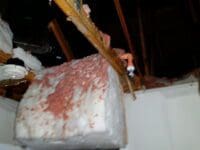 We recommend that you add additional insulation if you have pipes in your attic. We have been involved with several homes over the years that had pipes burst. This obviously causes flooding inside the home. You may want to read about Easy Ways to Prevent Home Flooding in Your Home. Flood damage in a home is probably the most devastating other than fire damage. Many times, this was a sprinkler system pipe running through the attic. If there is insufficient insulation and the temperatures are very cold, it can cause them to burst. This is particularly true if the home loses power during very cold temperatures or a winter storm.
We recommend that you add additional insulation if you have pipes in your attic. We have been involved with several homes over the years that had pipes burst. This obviously causes flooding inside the home. You may want to read about Easy Ways to Prevent Home Flooding in Your Home. Flood damage in a home is probably the most devastating other than fire damage. Many times, this was a sprinkler system pipe running through the attic. If there is insufficient insulation and the temperatures are very cold, it can cause them to burst. This is particularly true if the home loses power during very cold temperatures or a winter storm.
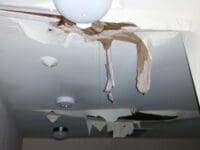 One home in particular was a bank-owned (REO) property that we were managing for the bank. The home was located in a relatively new subdivision in Waldorf, MD 20602. It all started on February evening in 2016. We received a phone call from a neighbor. We were told that there was water pouring of the house and ice forming on the vinyl siding and bricks. The temperatures were about 18 degrees that day and the home lost power. When we arrived at the home, we found substantial damage. This wasn’t caused by a winter storm, but simply very cold temperatures.
One home in particular was a bank-owned (REO) property that we were managing for the bank. The home was located in a relatively new subdivision in Waldorf, MD 20602. It all started on February evening in 2016. We received a phone call from a neighbor. We were told that there was water pouring of the house and ice forming on the vinyl siding and bricks. The temperatures were about 18 degrees that day and the home lost power. When we arrived at the home, we found substantial damage. This wasn’t caused by a winter storm, but simply very cold temperatures.
Upon opening the front door, we found that there was water pouring through the ceiling. It took a while to fully assess what had happened and document the damage. We ultimately determined that the preservation company that winterized the home failed to winterize the sprinkler system. We were able to turn off the sprinkler system water supply. That stopped the flow of water, but the damage was already done. It took several days for all of the water to stop dripping.
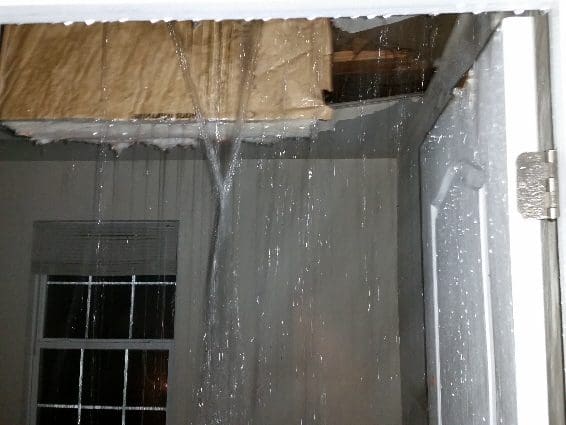
You should also add insulation in the walls where you have pipes close to an exterior wall. You may also want to wrap those pipes with some foam insulation. It will help to keep them warm in the event of a power outage. Maintaining a constant temperature inside the home can also help prevent burst pipes. As you can see, this causes massive damage. If you won’t be home, we recommend setting the thermostat at between 55 and 60 degrees.
Does Your Fireplace and
Chimney Function Correctly?
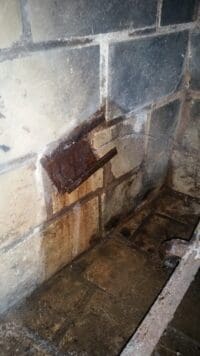 If you have a fireplace, you should have it inspected periodically. You should do that before a winter storm hits and also afterward, especially if there are high winds. You want to make sure that the fire box isn’t damaged and that the chimney is clean. If the fire box is damaged, it could allow water to come in through the bricks.
If you have a fireplace, you should have it inspected periodically. You should do that before a winter storm hits and also afterward, especially if there are high winds. You want to make sure that the fire box isn’t damaged and that the chimney is clean. If the fire box is damaged, it could allow water to come in through the bricks.
Also, look at the flashing around the chimney. You will want to check for any damage caused by a winter storm. If it has failed, water can get into the chimney through the flashing. Also, you want to check to see if the chimney cap is still in place. A missing chimney cap can allow animals and birds to get into the chimney to build nests.
It will also prevent snow, ice and water from getting into the chimney and causing damage. We have managed a few homes where this caused minor flooding.
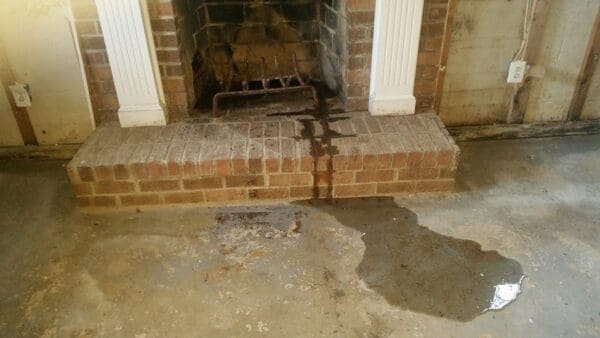
Some Final Thoughts
about Winter Storms
If you have a garage, make sure that you don’t start the car inside the garage to warm it up. You want to avoid any potential build-up of carbon monoxide. Make sure that your smoke detectors and CO2 detectors are working properly.
Finally, some homes have a generator that is professionally installed as part of the home’s electrical system. Some people choose to use a portable generator. These typically are powered by gasoline or propane. You need to make sure it the generator is running in a safe location. If you lose power and turn on the generator, you need to be sure that it is not bringing carbon monoxide back into your home or garage.
After a winter storm hits, look for damage to your home and personal property. If you find damage from the storm, you should document it for insurance purposes. That documentation should include photographs. It can also be helpful if you provide pictures from before the winter storm damage occurred. It’s likely that insurance companies and contractors will be very busy after a large winter storm ends, so you may need to be patient. Taking some pro-active measures, though, when a winter storm is coming can help eliminate many problems and minimize any damage.




